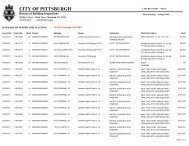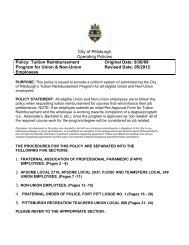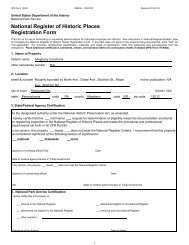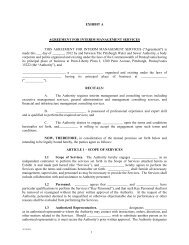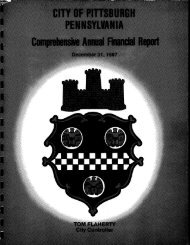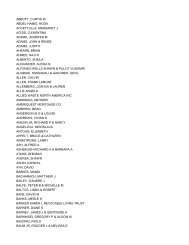east liberty station: realizing the potential - City of Pittsburgh
east liberty station: realizing the potential - City of Pittsburgh
east liberty station: realizing the potential - City of Pittsburgh
You also want an ePaper? Increase the reach of your titles
YUMPU automatically turns print PDFs into web optimized ePapers that Google loves.
TOD Typologies<br />
In recent years CTOD has developed<br />
<strong>the</strong> concept <strong>of</strong> <strong>station</strong> typologies which<br />
classify transit <strong>station</strong>s and development<br />
opportunities according to <strong>the</strong>ir location,<br />
function and more recently performance,<br />
in <strong>the</strong> larger urban region. Classification<br />
strategies tend to rely on measure <strong>of</strong><br />
residential and employment density,<br />
housing to employment ratios and<br />
sometimes vehicle miles traveled (VMT.)<br />
Classification strategies designed to guide<br />
development have tended to focus on<br />
measures <strong>of</strong> land use intensity (residents<br />
and worker in <strong>the</strong> half mile <strong>station</strong> area)<br />
versus land use mix (ratio <strong>of</strong> workers to<br />
residents.) This approach is illustrated in<br />
CTOD’s study <strong>of</strong> Los Angeles shown at left.<br />
This typically is paired with TOD guidelines<br />
for each <strong>station</strong> type. In this study we have<br />
used this methodology to classify East<br />
Liberty in relation to <strong>the</strong> o<strong>the</strong>r stops on<br />
<strong>the</strong> East Busway as means <strong>of</strong> identifying<br />
development targets.<br />
In <strong>the</strong>ir more recent Performance-Based<br />
Transit-Oriented Development Typology<br />
Guidebook a more research oriented<br />
measure is put forward to benchmark and<br />
compare existing <strong>station</strong> areas and how<br />
various metrics compare. The typology is<br />
based on VMT versus a slightly different<br />
measure <strong>of</strong> land use mix calculated as total<br />
workers / workers + residents. This method<br />
allowed CTOD to compare <strong>the</strong> performance<br />
<strong>of</strong> hundreds <strong>of</strong> existing <strong>station</strong> areas across<br />
<strong>the</strong> country to develop normative metrics<br />
for a variety <strong>of</strong> measures.<br />
TOD <strong>station</strong> typology<br />
matrix for Los Angeles<br />
CTOD - Creating<br />
Successful Transit-<br />
Oriented Districts in<br />
Los Angeles, 2010<br />
Normative Metrics for<br />
TOD Station Types<br />
CTOD - Performance-<br />
Based Transit-Oriented<br />
Development Typology<br />
Guidebook, 2010<br />
(residents+workers per half mile)<br />
INTENSITY<br />
200,000<br />
not to scale<br />
45,000<br />
30,000<br />
25,000<br />
0<br />
Vermont/Beverly<br />
HOUSING<br />
Hollywood/Western<br />
Wilshire/Normandie (66,701 persons)<br />
Wilshire/Vermont<br />
Wilshire/Western (50,289 persons)<br />
Westlake/MacArthur Park (46,965 persons)<br />
Vermont/Santa Monica<br />
Hollywood/Highland<br />
(54,775 persons)<br />
Vermont/Sunset<br />
Urban Neighborhood Urban Center CBD/Special District<br />
Hollywood/Vine<br />
Soto<br />
21,000<br />
Avenue 57/Highland Park<br />
San Pedro 23rd Street<br />
Sherman<br />
USC/Expo Park<br />
-30% Indiana Mariachi Plaza<br />
VMT<br />
Roscoe<br />
Reseda<br />
Van Nuys<br />
Laurel Canyon<br />
Vernon<br />
Western<br />
La Brea Slauson<br />
North Hollywood Washington/National<br />
12,000 Vermont<br />
103rd Street<br />
Van Nuys<br />
French/Heritage Square<br />
Imperial<br />
De Soto<br />
Woodman Avenue 26/Lincoln Heights<br />
La Cienga<br />
-30% Avalon Slymar/San Fernando<br />
VMT<br />
Pico Aliso<br />
Harbor Freeway<br />
Northridge<br />
Crenshaw<br />
Chatsworth<br />
Southwest Museum<br />
Sun Valley<br />
7,000<br />
Woodley<br />
Pierce College<br />
Valley College<br />
Cal State LA<br />
5,000<br />
Tampa<br />
Balboa<br />
Transit Neighborhood Mixed Use Center Business District<br />
Sepulveda<br />
Universal <strong>City</strong><br />
0.5 1 1.5 2<br />
MIX (ratio <strong>of</strong> workers to residents)<br />
Grand<br />
Warner Center<br />
Suburban Neighborhood Neighborhood Center Office/Industrial District<br />
Table 4. Normative Metrics<br />
Place Types<br />
Total Intensity<br />
(residents + workers)<br />
Low VMT<br />
Low-Mod<br />
VMT<br />
Canoga<br />
Washington<br />
Nordh<strong>of</strong>f<br />
Pico/Convention Center<br />
(5.6 workers/resident)<br />
Glendale (3.0 workers/resident)<br />
Vermont (3.75 workers/resident)<br />
Aviation<br />
(5.5 workers/resident)<br />
not to scale<br />
3 25<br />
EMPLOYMENT<br />
Performance-Based Transit-Oriented Development Typology Guidebook<br />
Civic Center<br />
(24 workers/resident,<br />
(180,423 persons)<br />
Pershing Square(6.7 workers/resident,<br />
85,244 persons)<br />
Union Station(6.4 workers/resident,<br />
82,674 persons)<br />
Chinatown<br />
(6.3 workers/resident, 7th Street<br />
75,653 presons)<br />
(11.2 workers/resident,<br />
65,972 persons)<br />
Little Tokyo/Arts District<br />
(9.9 workers/resident, 56,107 persons)<br />
Jefferson (3.8 workers/resident)<br />
Residential Places Balanced Places Employment Places<br />
Mod VMT<br />
High-Mod<br />
VMT<br />
High VMT<br />
Low VMT<br />
Low-Mod<br />
VMT<br />
Mod VMT<br />
High-Mod<br />
VMT<br />
High VMT<br />
Low VMT<br />
Low-Mod<br />
VMT<br />
Mod VMT<br />
Blue Line<br />
Expo<br />
Gold<br />
Green<br />
Metrolink<br />
Orange<br />
Subway<br />
High-Mod<br />
VMT<br />
54,216 24,718 12,580 7,708 3,429 64,155 21,763 11,600 6,867 3,242 109,306 34,914 13,009 5,969 2,325<br />
Residents 44,293 20,106 10,229 6,292 2,716 29,875 10,732 5,884 3,695 1,764 12,581 5,103 2,065 1,154 321<br />
Workers 9,923 4,612 2,351 1,416 713 34,280 11,031 5,716 3,172 1,478 96,725 29,811 10,944 4,815 2,004<br />
Workers/Residents 18.3% 19.5% 19.6% 20.3% 19.6% 51.6% 49.7% 48.2% 46.0% 46.2% 86.5% 83.9% 84.2% 83.0% 87.1%<br />
Households 16,214 7,684 3,906 2,253 974 15,466 4,646 2,429 1,467 670 6,828 2,524 861 467 120<br />
Household Size 2.71 2.61 2.62 2.71 2.68 1.95 2.21 2.41 2.43 2.60 1.58 1.67 2.22 2.28 2.64<br />
Gross Density<br />
(units/acre)<br />
Residential Density<br />
(units/acre)<br />
50.0 21.6 10.3 5.7 2.2 48.7 16.4 7.6 4.0 1.9 28.5 10.3 4.6 2.2 0.9<br />
53.2 23.6 12.1 6.7 3.4 55.6 20.9 10.5 5.8 3.5 51.4 20.6 10.8 6.0 2.9<br />
Block Size (acres) 4.2 4.1 5.7 7.7 18.8 3.7 5.8 8.5 9.9 23.7 3.7 6.4 14.2 69.9 86.7<br />
Monthly T Cost $422 $563 $688 $781 $906 $394 $597 $721 $794 $900 $463 $613 $713 $793 $920<br />
Yearly T Cost $5,064 $6,756 $8,256 $9,372 $10,872 $4,728 $7,164 $8,652 $9,528 $10,800 $5,556 $7,356 $8,556 $9,516 $11,040<br />
Average Median<br />
Income (1999)<br />
Travel Time to Work<br />
(minutes)<br />
Employment<br />
Proximity<br />
High VMT<br />
$31,713 $35,643 $41,344 $53,492 $62,06t9 $43,997 $37,364 $43,395 $51,138 $65,544 $41,875 $34,183 $43,935 $40,985 $57,562<br />
35.6 31.4 27.4 25.5 24.7 23.5 22.1 21.4 21.6 22.9 18.0 17.1 18.7 19.0 21.5<br />
233,890 127,448 65,640 42,260 20,788 451,725 152,310 73,393 41,335 27,131 396,277 159,118 99,648 58,747 32,167<br />
Transit Access Index 31 19 13 10 3 56 28 11 9 4 85 45 19 10 4<br />
Autos/Household 0.45 0.82 1.18 1.47 1.71 0.52 0.87 1.22 1.41 1.68 0.48 0.74 1.11 1.18 1.61<br />
Home Journey to<br />
Work Transit<br />
Home Journey to<br />
Work Walk/Bike/<br />
Transit<br />
Workplace Journey<br />
to Work Transit<br />
Workplace Journey<br />
to Work Walk/Bike/<br />
Transit<br />
58% 39% 23% 15% 8% 43% 25% 14% 10% 8% 25% 16% 13% 9% 5%<br />
68% 47% 27% 18% 10% 64% 40% 23% 15% 11% 58% 37% 24% 18% 9%<br />
33% 20% 11% 7% 2% 38% 17% 8% 5% 3% 38% 16% 9% 5% 3%<br />
47% 30% 18% 12% 6% 48% 23% 12% 8% 5% 43% 19% 11% 7% 5%<br />
<br />
15<br />
y



